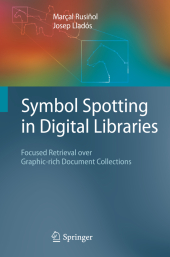 Neuerscheinungen 2014Stand: 2020-02-01 |
Schnellsuche
ISBN/Stichwort/Autor
|
Herderstraße 10
10625 Berlin
Tel.: 030 315 714 16
Fax 030 315 714 14
info@buchspektrum.de |

Josep Lladós, Mar‡al Rusi¤ol
(Beteiligte)
Symbol Spotting in Digital Libraries
Focused Retrieval over Graphic-rich Document Collections
2010. 2014. xiv, 180 S. 235 mm
Verlag/Jahr: SPRINGER, BERLIN; SPRINGER, LONDON; SPRINGER 2014
ISBN: 1-447-16179-3 (1447161793)
Neue ISBN: 978-1-447-16179-0 (9781447161790)
Preis und Lieferzeit: Bitte klicken
Here is a complete, integrated, large-scale solution to the challenge of designing a robust symbol-spotting method for collections of graphic-rich documents. The book presents a methodology which can be used in a wide variety of applications.
Pattern recognition basically deals with the recognition of patterns, shapes, objects, things in images. Document image analysis was one of the very ?rst applications of pattern recognition and even of computing. But until the 1980s, research in this ?eld was mainly dealing with text-based documents, including OCR (Optical Character Recognition) and page layout analysis. Only a few people were looking at more speci?c documents such as music sheet, bank cheques or forms. The community of graphics recognition became visible in the late 1980s. Their speci?c interest was to recognize high-level objects represented by line drawings and graphics. The speci?c pattern recognition problems they had to deal with was raster-to-graphics conversion (i.e., recognizing graphical primitives in a cluttered pixel image), text-graphics separation, and symbol recognition. The speci?c problem of symbol recognition in graphical documents has received a lot of attention. The symbols to be recognized can be musical notation, electrical symbols, architectural objects, pictograms in maps, etc. At ?rst glance, the symbol recognition problems seems to be very similar to that of character recognition; - ter all, characters are basically a subset of symbols. Therefore, the large know-how in OCR has been extensively used in graphical symbol recognition: starting with segmenting the document to extract the symbols, extracting features from the s- bols, and then recognizing them through classi?cation or matching, with respect to a training/learning set.
Introduction.- State of the Art in Symbol Spotting.- Part I: On the Use of Photometric.- Descriptors for Symbol Spotting.- Symbol Spotting for Document Categorization.- Part II: On the Use of Geometric and Structural Constraints for Symbol Spotting.- Vectorial Signatures for Symbol Recognition and Spotting.- Symbol Spotting Through Prototype-based Search.- A Relational Indexing Method for Symbol Spotting.- Part III: A Performance Evaluation Protocol for Symbol Spotting Systems.- Performance Evaluation of Symbol Spotting Systems.- Conclusions.
From the reviews:
"This monograph is a clearly written and accessible survey and framework for the field, and it should prove useful to researchers and students in computer vision, pattern recognition, and related fields. It would also be instructive for advanced practitioners in these areas ... . References are provided at the end of each chapter for researchers who need or want to refer to the primary literature. In short, this book is a concise, readable, and informative resource on its specialized problem domain and related areas." (R. M. Malyankar, ACM Computing Reviews, October, 2010)


